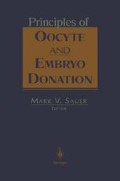Abstract
A parent is defined as one who brings forth offspring.1 In most cases, offspring result from a husband and wife producing gametes that lead to conception in the mother’s uterus. Unfortunately, this is not always the case, and approximately 15% of reproductive age couples are faced with infertility and left to choose between expensive treatment, adoption, or a foster child.2 New hope for these couples arrived in 1978 when Steptoe and Edwards reported the first livebirth from in vitro fertilization (IVF).3 In vitro fertilization offered women with tubal disease a new technique that would give them a chance at pregnancy. Yet, despite the promise of various assisted reproductive technologies (ART) such as in vitro fertilization, gamete intrafallopian tube transfer (GIFT), and zygote intrafallopian tube transfer (ZIFT), many couples still face a childless life. This is particularly true of couples in which the female has either premature ovarian failure or an abnormal or absent uterus. Not until egg donation and surrogacy became available did women with these afflictions have the opportunity to become pregnant. Hence, the introduction of alternatives to treatment, involving principally third parties, has dramatically broadened the spectrum of treatable cases. While the use of third parties is relatively new to the management of infertile females, there is a strong tradition in treating males. Therapeutic donor insemination has long been used in couples limited by male factor infertility.4
Access this chapter
Tax calculation will be finalised at checkout
Purchases are for personal use only
Preview
Unable to display preview. Download preview PDF.
References
Webster’s Ninth New Collegiate Dictionary. Springfield, Mass: Merriam-Webster, 1990.
Mosher WD, Pratt WF. Fecundity and infertility in the United States: incidence and trends. Fertil Steril. 1991; 56: 192.
Steptoe PC, Edwards RG. Birth after the reimplantation of a human embryo. Lancet. 1978; 2: 366.
Shapiro S, Saphine D, Stone W. Changes in American AID practice during the past decade. Int J Fertil. 1990; 35: 284.
Gregorie AT, Mayer RC. The impregnators. Fertil Steril. 1965; 15: 130.
Kleegman SJ. Therapeutic donor insemination. Fertil Steril. 1954; 5: 7.
Bunge RG, Sherman JK. Fertilizing capacity of frozen human spermatozoa. Nature. 1953; 172: 767.
Jalbert P, Leonard C, Selva J, David G. Genetic aspects of artificial insemination with donor semen: the French CECOS federation guidelines. Am J Med Genet. 1989; 33: 269.
Subak LL, Adamson GD, Boltz NL. Therapeutic donor insemination: a prospective randomized trial of fresh versus frozen sperm. Am J Obstet Gynecol. 1992; 166: 1597.
Shenfield F, Doyle P, Valentine A, Steele SJ, Tan S-L. Effects of age, gravidity and male infertility status on cumulative conception rates following artificial insemination with cryopreserved donor semen: analysis of 2998 cycles of treatment in one centre over 10 years. Hum Reprod. 1993; 8: 60.
Amuzu B, Laxova R, Shapiro SS. Pregnancy outcome, health of children, and family adjustment after donor insemination. Obstet Gynecol. 1990; 75: 899.
Van Steirtegham AC, Liu J, Joris H, Nagy Z, Janssenwillen C, Tournaye H, Derde M-P, Assche EV, Devroey P. Higher success rate by intracytoplasmic sperm injection than by subzonal insemination: report of a second series of 300 consecutive treatment cycles. Hum Reprod. 1993; 8: 1055.
David A, Avidan D. Artificial insemination donor: Clinical and psychological aspects. Fertil Steril. 1976; 27: 528.
Sauer MV, Paulson RJ. Human oocyte and preembryo donation: an evolving method for the treatment of infertility. Am J Obstet Gynecol. 1990; 163: 1421.
Rosenwaks Z. Donor eggs: their application in modern reproductive technologies. Fertil Steril. 1987; 47: 895.
Baird PA. Ethical issues of fertility and reproduction. Annu Rev Med. 1996; 47: 107.
Braverman AM. Ovum donor task force of the Psychological Special Interests Group of The American Fertility Society. Survey results on the current practice of ovum donation programs. Fertil Steril. 1993; 59: 1216.
Sureau C, Shenfield F. Oocyte donation by a daughter. Hum Reprod. 1995; 10: 1334.
Braverman AM, Corson SL. Factors related to preferences in gamete donor sources. Fertil Steril. 1995; 63: 543.
Sauer MV, Paulson RJ, Lobo RA. Pregnancy after age 50: application of oocyte donation to women after natural menopause. Lancet. 1993; 341: 321.
Sauer MV, Paulson RJ, Lobo RA. Reversing the natural decline in human fertility: an extended clinical trial of oocyte donation to women of advanced reproductive age. JAMA. 1992; 268(10): 1275.
Lessor R, Cervantes N, O’Connor N, Balmaceda J, Asch RH. An analysis of social and psychological characteristics of women volunteering to become oocyte donors. Fertil Steril. 1993; 59: 65.
Snowdon C. What makes a mother? interviews with women involved in egg donation and surrogacy. Birth. 1994; 21: 77.
Utian WH, Sheean L, Goldfarb JM, Kiwi R. Successful pregnancy after in vitro fertilization and embryo transfer from an infertile woman to a surrogate. N Engl J Med. 1985; 313: 1351.
American Fertility Society. The American Fertility Society ethical considerations of the new reproductive technologies by the Ethics Committee. Fertil Steril. 1994; 62 (suppl): 71S.
The American Fertility Society. Guidelines for gamete donation. Fertil Steril. 1993; 1: 1S.
Editor information
Editors and Affiliations
Rights and permissions
Copyright information
© 1998 Springer Science+Business Media New York
About this chapter
Cite this chapter
McConnell, R.A. (1998). Alternative Parenting: A Practitioner’s View. In: Sauer, M.V. (eds) Principles of Oocyte and Embryo Donation. Springer, New York, NY. https://doi.org/10.1007/978-1-4612-1640-7_18
Download citation
DOI: https://doi.org/10.1007/978-1-4612-1640-7_18
Publisher Name: Springer, New York, NY
Print ISBN: 978-1-4612-7226-7
Online ISBN: 978-1-4612-1640-7
eBook Packages: Springer Book Archive

